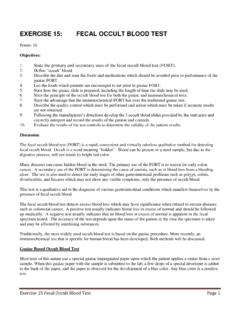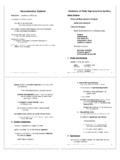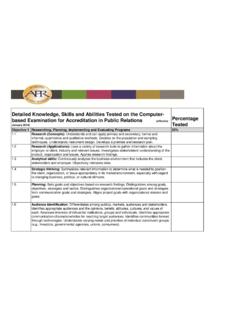Transcription of Microscopic Examination of Urine - Austin Community College
1 Microscopic Examination of Urine Download Definition of Urine sediment: all solid materials suspended in the Urine - a semiquantative evaluation of the Urine sediment Significance of formed elements in the Urine Well performed Microscopic exam can provide information nearly equivalent to a biopsy. Most time consuming part of UA & until recently the least standardized. Ongoing controversy as to when / if to perform the Microscopic Examination of Urine Not on lecture guide. Review info in Table 6-1 Correlation of findings from physical & chemical analysis with expectations in TestSignificance (or what to look for)Nitrite positiveWBCs / bacteriaLeukocyte esterase pos WBCs, WBC casts, bacteriaGlucose positiveyeastsMicroscopic Examination of Urine Specimen requirements Collection of specimen Prefer the concentrated first morning specimen, collected = mid-stream, clean catch . first morning most concentrated and will be able to demonstrate the most abnormalities.
2 Mid stream, clean catch technique will eliminate fecal & vaginal contamination Container must be clean and free of lint / debris usually disposable plastic, must be sure no soap residue Fresh tested within 2 hours of voiding, or refrigeration Examination of Urine List the correct steps in the collection and preparation of a Urine sample for Microscopic exam. Preparation of specimen need to standardize as much as possible Sources of Variation (not on lecture guide) Collection method Centrifugation time and speed Re-suspension of sediment Type of microscope slide Viscosity of specimen Reporting of the resultsMicroscopic Examination of Urine Preparation of specimen (show video) Mix specimen well Pour 12 ml into Urine centrifuge tube Centrifuge five minutes, 1200-2000 RPM (speed varies depending on the centrifuge s characteristics) Speed and time should be consistent. The relative centrifugal force is important. Microscopic Examination of UrineMicroscopic Examination of Urine Pour off supernatant - except last.
3 5-1 mL. have pipettes that assist Re-suspend sediment - mix well, tap, or use pipette provided Evaluate sediment in a chamber standardized for given volume and depth of field. - In-house methods = Mount a smalldrop on a clean slide, cover-slip - or use commercial materials such as Count 10 Use standardized reporting format consistent with other techs in the institutionMicroscopic Examination of Urine Commercial systems UriSystem slide to follow KOVA System video or several slides to follow Count -6 or Count 10 all have their own brand of tubes, pipettes, stain, slides, etc. Authors also mentions several other all in one-type of systems Microscopic Examination of Urine UniSystem Standardization of Urine SedimentMicroscopic Examination of Urine Sedi-Stain (Sternheimer and Malbin) crystal violet, safranin-O Sedi-Stain & KOVA stain are commercial preparations with addition of stabilizers to prevent precipitation. Supra-vital stain used to increase visibility of structures.
4 Assists greatly in differentiating renal tubular epithelial cells (which will take on an eosinophilic - oranges cytoplasm & dk purple nuclei) from transitional epithelial (which are more over-all blue) Microscopic Examination of Urine Not on lecture guide Table 6-3 Sediment stain characteristics Toluidine blue nuclear structure Assists in differentiating WBC from renal epith. 2% acetic acid - removes interfering RBCsand enhances nuclei of WBC Lipid stains - Oil Red O, Sudan III - stains triglycerides and neutral fats orange-red to ID lipid containing Examination of Urine Gram stain - to assist in ID of gram reaction of bacteria. Hansel stain - methylene blue and eosin Y stains eosinophilic granules - ID eosinophils Prussian blue reaction - makes iron granules blue in color (hemosiderin granules appear yellow until stained) Microscopic Examination of Urine Table 6-5 page 73 provides information on types of Microscopic techniques that have application in UABrighfield microscope very subdued light: lowered condenser, closed iris diaphragm, use filters Continuously focus up and down with fine adjustment as you learned in hematology.
5 Polarized light - may use to ID crystals, lipidsMicroscopic Examination of Urine Types of Sediment As one author puts it: Cells Casts Crystals CrittersMicroscopic Examination of Urine Types of Sediment Organized biological part RBC WBC Casts Epithelial cells Bacteria, parasites, yeast and fungi Unorganized Crystals Amorphous crystalline Examination of Urine Examination - should correlate with physical and chemical dipstick, may need to recheck Scanning - 10-15 fields using low power (10X). Look for casts, mucous, and squamousepithelial cells in general getting an overall feel Report squamous epithelial cells, crystals, mucous, etc. using semi-quantitative terms such as rare, few, moderate, or many (or trace, 1+,2+,3+, & 4+) according to lab Examination of Urine Enumeration - quantitate. Method may vary from lab to lab Average number of RBC/hpf Average number of WBC/hpf Average number of any renal tubular or transitional epithelial cells Examination of UrineAverage number (and type) of casts/__average # of casts /hpf_____ authors have varied back and forth as whether low or high power should be use low power to locate and enumerate the various types , but may need to switch to high power to identify the Strasinger says report / lpf (use hpf to ID) Unorganized sediment few, moderate, many, packed; kinds seen Note presence of bacteria, yeasts, crystals, epithelial cells (covered), etc.
6 Quantitate these alsoMicroscopic Examination of Urine .Changes in Urine sediment when allowed to stand important to keep in mind the changes in Microscopic structuresthat can occur (don t forget the other chemical changes ie bilirubin, pH, ketones) RBC distorted crenation, swelling, disintegration WBC disintegrates in alkaline Urine Cast disintegrate in alkaline Urine Bacterial growth increased alkalinity Increased precipitation of crystals, especially amorphousMicroscopic Examination of Urine Microscopic sediment Red Blood Cells White Blood Cells Epithelial Cells Casts Crystals Miscellaneous structures Students go to end of area s lecture guide. Continue to next Examination of Urine Addis Count Strasinger page 68 Early way of accurately enumerating Urine sediment. Actual enumeration of casts, RBC, WBC, using a hemacytometer developed as a way to standardize Urine microscopics to monitor known cases of renal disease. Rarely done today as most Urine Microscopic systems produce standardized results if manufacture directions are followed.
















